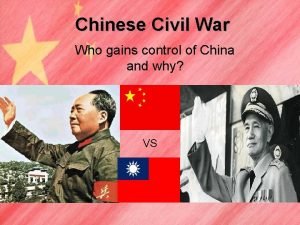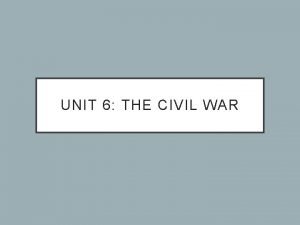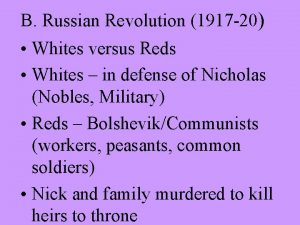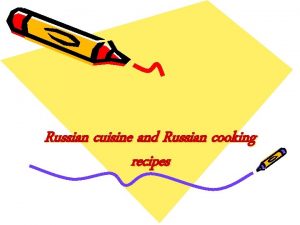Reasons why the Reds won the Russian Civil










- Slides: 10

Reasons why the Reds won the Russian Civil War

Intro • Background – Bolsheviks seize power in October 1917 revolution. They pull Russia out of WW 1 which many wanted. Despite this, they still face opposition from several groups, collectively known as the Whites. Leads to civil war which the Reds win. • Factors – Superior resources, Weakness of Whites, Leadership of Lenin and Trotsky, Ruthlessness of Bolsheviks. • Argument – You must decide which factor was the biggest and argue this through the essay.

Superior Resources • Geography – Red control central-West of Russia which is most heavily populated area (KU) • This gives them a larger reservoir of manpower to call on – Nearly 10 times the size of the White army (A) • Also, this gives them access to all the leftover weapons from WW 1 and arms factories as they are located here – Superior arsenal to the Whites (A) • Control Moscow – Main hub of railway network (KU) • Can transport troops quickly around Russia (A) • Richard Pipes – Victory was a ‘foregone conclusion’ because the Reds controlled these areas. (A+ - Historiography)

Superior resources - Evaluation • The Red’s superior resources and geography was vital as it allowed them to create a solid defensive line around their territory because they could transport troops and resources to these areas when necessary.

Weakness of Whites • Biggest weakness is disunity of the Whites and their leadership. • White leaders divided in their opinion of how Russia should be ruled – only thing they have in common is hatred of Bolsheviks (KU) • White leaders distrust each other – especially Kolchak and Denikin (KU) • This led to a lack of communication and disagreement between the Whites made them much easier to defeat (A) • Reds also had strong leaders in Lenin and Trotsky and were all committed to the survival of Communism, so they had a firm ideology driving them (A+ - Linking factors)

Weakness of Whites • Whites control the outer regions of Russia. Armies are far apart and they do not have advantage of railways (KU) • This made it much more difficult to effectively fight the Bolsheviks as they had to send their troops far distances and made it difficult to communicate (A+ - Linking factors) • Whites rely heavily on foreign intervention from France, Britain and America – guns, troops, etc. Allied enthusiasm drops massively when Germany surrender in 1918 – Many foreign troops left by 1919. • Because of this they made little impact on the fighting in the Civil War (A) • Mawdsley argues that ‘foreign intervention was half hearted and militarily ineffective’ (A+ - Historiography)

Weakness of Whites evaluation • Foreign intervention was actually counterproductive for the Whites – It allowed the Reds to paint themselves as pro-Russian patriots in their propaganda and claim the Whites wanted to return Russia to the way it was run before the revolution, which many did not want.

Leadership of Lenin • Lenin remained in Moscow and directed the Red forces from there. His leadership was unquestioned. • Introduced War Communism – Took control of industry and made sure that all efforts went towards the war effort (KU) and made sure the Red’s continually had superior resources (A+ - Linking factors) • Hard headed decision maker – Makes the decision to abandon the Finnish communists in their fight in order to maintain the areas the Red’s control. This is a key reason why they are able to keep hold of these areas and, therefore, keep hold of the superior resources (A+ Linking factors)

Leadership of Trotsky Commissar of War – In charge of creating and leading Red Army (KU) Recruited 50, 000 ex-Tsarist officers and introduced conscription in 1921 (KU) This led to the Reds having a large, well trained army (A) Enforced strict discipline – tough punishments for desertion or disloyalty (KU) This ensured the army was loyal to Communism and well disciplined. Travelled in Russia in his armoured train and delivered inspirational messages to troops (KU) • Led to a high morale in the Red army (A) • Robert Service argues that Trotsky was the main reason for the Red victory because of his ruthlessness and the fact he created a strong fighting force (A+ Historiography) • • •

Ruthlessness of Bolsheviks used terror to make sure they were not challenged. Cheka executes Tsar and family in 1918 (KU) This removed any possibility of Romanovs being restored (A) Cheka was used to supress any opposition – Torture and executions used – 140, 000 executions including any leaders of other political parties (which Lenin made illegal). (KU) • This made people too scared to oppose the Bolsheviks (A) • Lenin’s war communism also led to huge famines in Russia and was devastating for many peasants as they had to hand over their grain to the Bolsheviks for a fixed price, regardless of how much they produced. (KU) • Lenin saw this as a necessary evil and continued with the policy despite the terrible impact on peasants. This ruthlessness, and Lenin’s decision making, meant that the Bolsheviks were always supplied and was vital in them winning. (A+ - Linking factors) • •



















